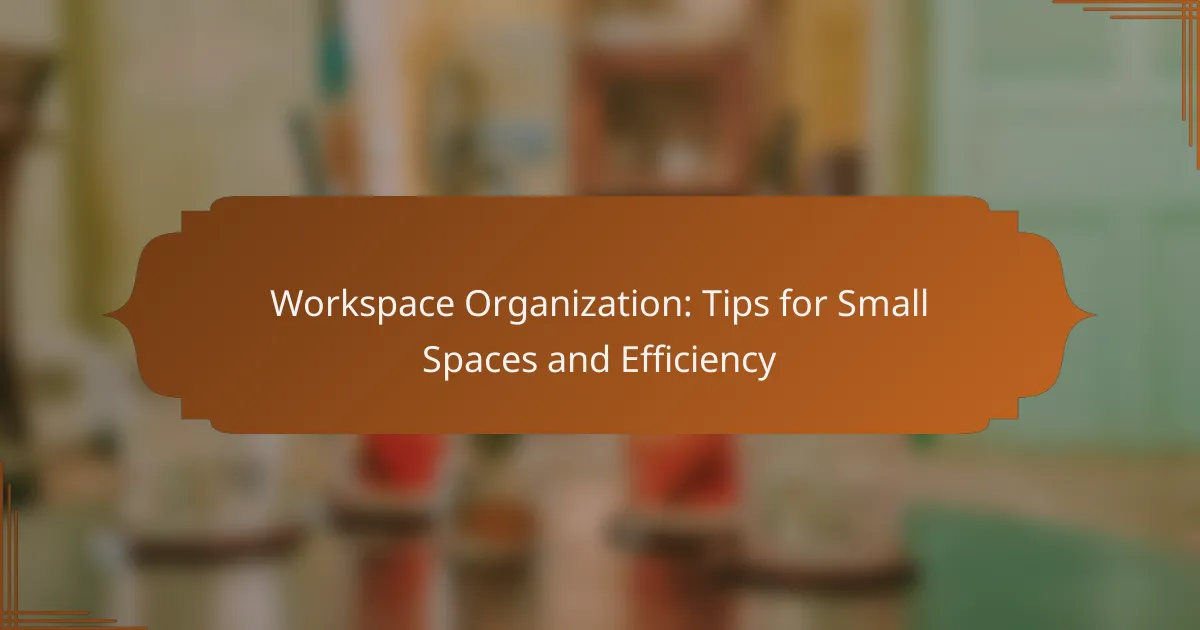Organizing a small workspace effectively requires a strategic approach to maximize every inch while maintaining functionality. By utilizing versatile storage solutions and minimizing clutter, you can create an efficient and comfortable environment that enhances productivity and focus.
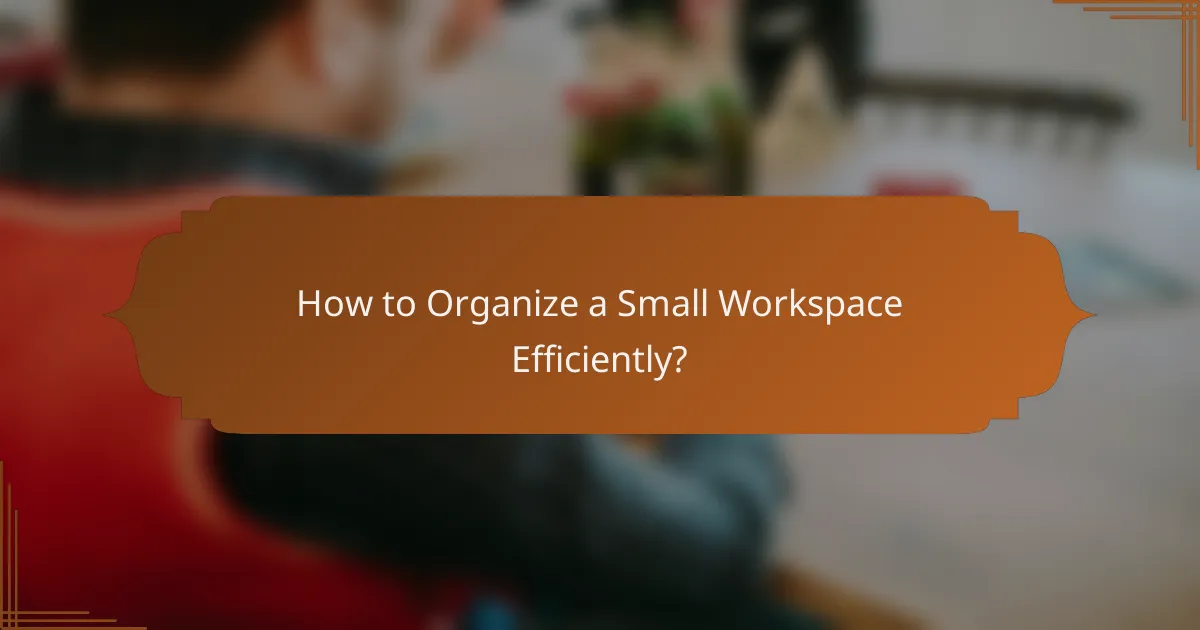
How to Organize a Small Workspace Efficiently?
To organize a small workspace efficiently, focus on maximizing every inch of available space while ensuring functionality. Prioritize solutions that enhance productivity and create a comfortable working environment.
Use vertical storage solutions
Vertical storage solutions are essential in small workspaces as they utilize wall space effectively. Consider shelving units, pegboards, or wall-mounted organizers to keep items off your desk and within easy reach.
Incorporate stackable bins or floating shelves to store supplies, books, or files. This not only saves floor space but also creates a visually appealing layout that can enhance your focus.
Implement multi-functional furniture
Multi-functional furniture is a game-changer for small workspaces, allowing you to maximize utility without overcrowding. Look for desks that can double as storage units or chairs that can convert into guest seating.
Consider foldable tables or desks that can be tucked away when not in use. This flexibility can help maintain an organized and spacious environment, making it easier to switch between tasks.
Declutter regularly
Regular decluttering is vital for maintaining an efficient workspace. Set aside time weekly or monthly to review your items and remove anything that is no longer necessary or useful.
Adopt the “one in, one out” rule: for every new item you bring in, consider removing an old one. This practice helps prevent accumulation and keeps your workspace streamlined and functional.
Utilize wall space for organization
Utilizing wall space for organization can significantly enhance the efficiency of a small workspace. Install hooks, magnetic strips, or wall-mounted baskets to keep tools and supplies accessible yet out of the way.
Consider using a corkboard or whiteboard for notes and reminders, which can help keep your desk clear while keeping important information visible. This approach not only organizes but also adds a personal touch to your workspace.
Incorporate smart lighting
Smart lighting can improve both the functionality and ambiance of a small workspace. Use adjustable lamps or smart bulbs that allow you to change brightness and color temperature based on the time of day or task at hand.
Consider task lighting for specific areas, such as your desk or reading nook, to reduce eye strain and create a more comfortable working environment. Proper lighting can enhance productivity and make your workspace feel more inviting.
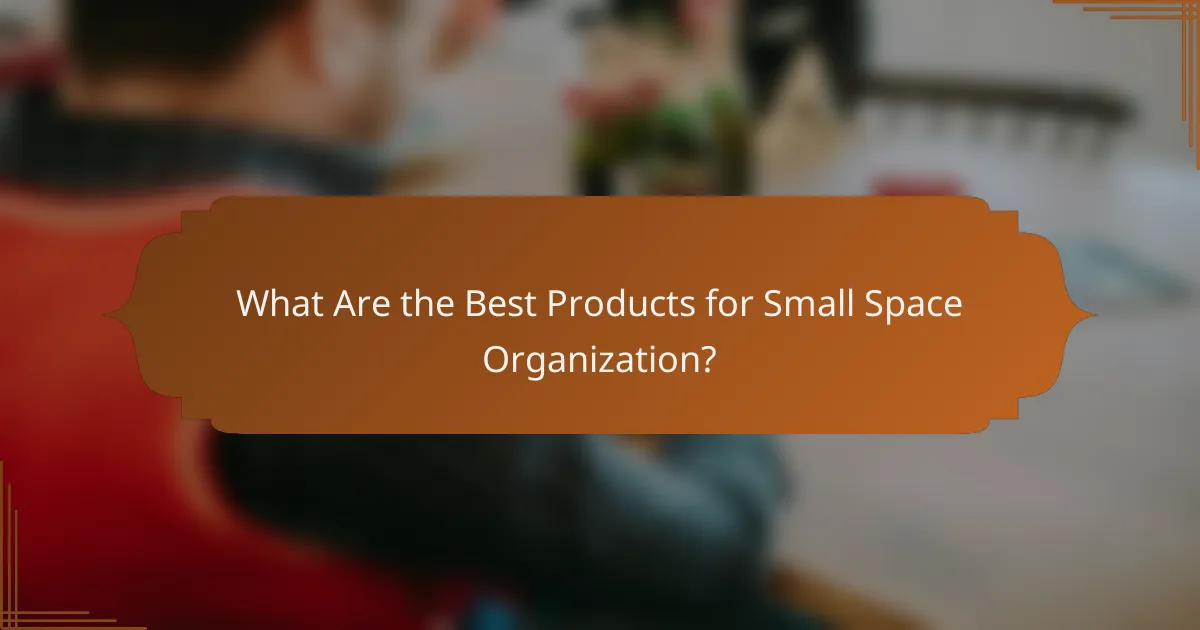
What Are the Best Products for Small Space Organization?
Effective small space organization relies on versatile products that maximize storage while minimizing clutter. Key items include storage bins, wall-mounted shelves, compact desks, under-desk storage solutions, and magnetic organizers, each designed to optimize limited areas.
Storage bins and baskets
Storage bins and baskets are essential for keeping small spaces tidy. They come in various sizes and materials, allowing you to choose options that fit your decor and storage needs. Look for stackable or collapsible designs to save space when not in use.
Consider using labeled bins to categorize items, making it easier to find what you need quickly. For example, use one bin for office supplies and another for craft materials, ensuring everything has a designated spot.
Wall-mounted shelves
Wall-mounted shelves free up floor space while providing storage and display options. They can hold books, plants, or decorative items, adding both functionality and style to your workspace. Choose shelves that are easy to install and can support the weight of your items.
When selecting wall-mounted shelves, consider adjustable options that allow you to customize the height and spacing based on your needs. This adaptability is especially useful in small areas where every inch counts.
Compact desks
Compact desks are designed to fit in tight spaces without sacrificing functionality. Look for desks with built-in storage or foldable designs that can be tucked away when not in use. These desks often come in various styles, from minimalist to more traditional looks.
When choosing a compact desk, ensure it has enough surface area for your work essentials. A desk with a width of around 40-50 cm can be ideal for small spaces, providing enough room for a laptop and some stationery.
Under-desk storage solutions
Under-desk storage solutions maximize the area beneath your desk, keeping items organized and out of sight. Options include rolling carts, drawer units, or hanging organizers that can accommodate office supplies, files, or personal items.
When selecting under-desk storage, measure the space available to ensure a proper fit. Look for units with wheels for easy mobility, allowing you to rearrange your workspace as needed.
Magnetic organizers
Magnetic organizers are a clever way to utilize vertical space and keep small items accessible. These can be mounted on walls or the sides of desks to hold tools, stationery, or even kitchen utensils in a home office setting.
Consider magnetic strips or boards that allow you to customize the arrangement of your items. This flexibility makes it easy to change your setup as your needs evolve, ensuring your workspace remains functional and organized.
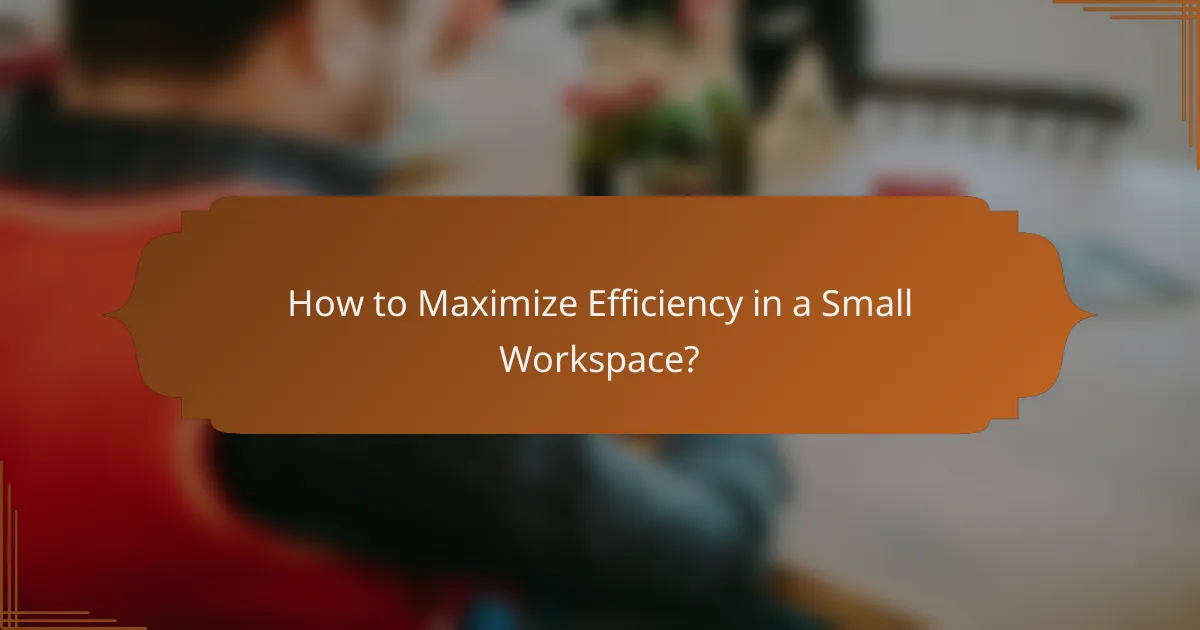
How to Maximize Efficiency in a Small Workspace?
To maximize efficiency in a small workspace, focus on organization, minimizing distractions, and utilizing productivity tools. These strategies help create a conducive environment that enhances focus and productivity.
Establish a daily routine
A daily routine sets a structured framework for your workday, making it easier to stay on task. Start by defining specific work hours and sticking to them to create consistency.
Incorporate regular breaks to recharge; for example, use the Pomodoro technique, which involves working for 25 minutes followed by a 5-minute break. This method can help maintain high energy levels throughout the day.
Minimize distractions
Reducing distractions is crucial for maintaining focus in a small workspace. Identify common interruptions, such as phone notifications or background noise, and take steps to eliminate them.
Consider using noise-canceling headphones or setting specific times to check emails and messages. Creating a designated work zone can also signal to others that you are focused and not to be disturbed.
Set clear goals and priorities
Setting clear goals and priorities helps direct your efforts effectively. Start each day by listing tasks in order of importance, focusing on what needs to be accomplished first.
Utilize the SMART criteria—Specific, Measurable, Achievable, Relevant, Time-bound—to define your goals. This approach ensures that your objectives are clear and attainable within your workspace constraints.
Use productivity tools
Productivity tools can streamline your workflow and enhance efficiency. Consider using task management apps like Trello or Asana to keep track of your projects and deadlines.
Additionally, tools like Google Calendar can help you schedule tasks and reminders, ensuring that you stay on track throughout the day. Explore options that fit your working style and integrate them into your routine.
Optimize your layout
Optimizing your workspace layout can significantly impact your efficiency. Arrange your desk to keep frequently used items within arm’s reach, reducing the time spent searching for tools or documents.
Use vertical space for storage with shelves or wall-mounted organizers to keep your desk clutter-free. Ensure that your chair and desk height are ergonomically suitable to promote comfort during long working hours.
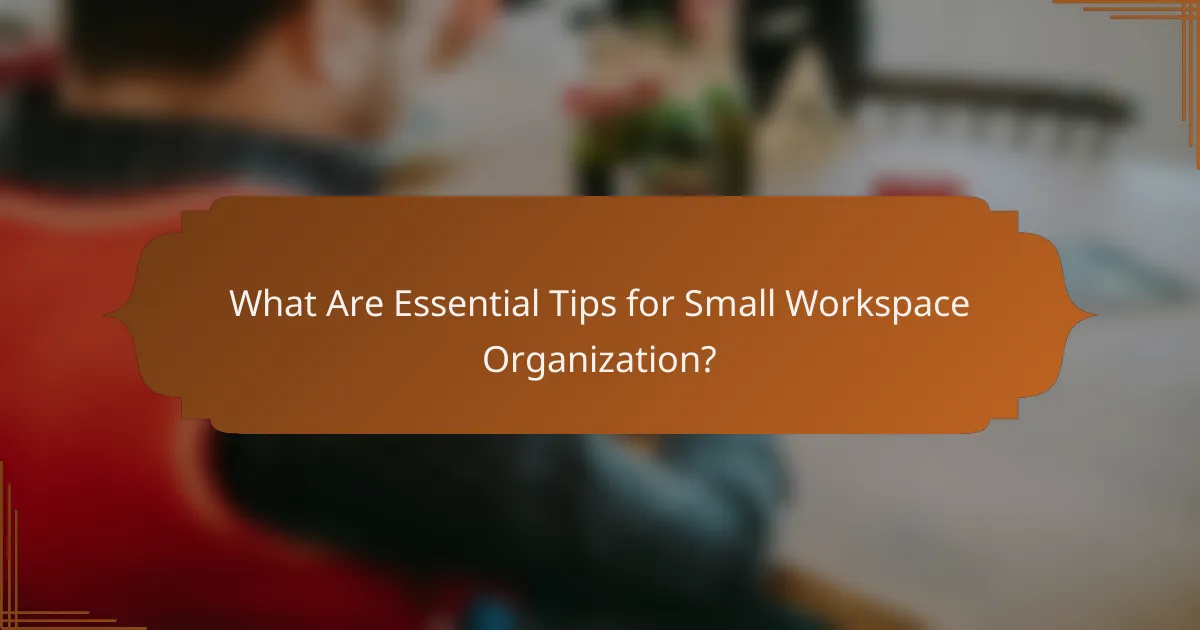
What Are Essential Tips for Small Workspace Organization?
Essential tips for small workspace organization focus on maximizing efficiency and minimizing clutter. By implementing practical strategies, you can create a functional and inviting environment even in limited spaces.
Keep frequently used items accessible
To enhance efficiency, position frequently used items within easy reach. This could mean keeping essential tools like pens, notepads, or a computer mouse on your desk rather than in drawers. Consider using desktop organizers to maintain a tidy appearance while ensuring accessibility.
Evaluate your daily tasks to identify which items you use most often. Aim to keep these items within arm’s length to reduce time spent searching for them, ultimately boosting your productivity.
Label storage containers
Labeling storage containers is a straightforward way to improve organization. Clear labels help you quickly identify contents, reducing the time spent rummaging through boxes or drawers. Use a label maker or simple sticky notes for a clean look.
Consider categorizing items by type or function. For instance, you might label containers for office supplies, documents, or personal items. This method not only streamlines your workspace but also makes it easier for others to find and return items.
Incorporate plants for a calming effect
Adding plants to your workspace can create a calming atmosphere and improve air quality. Choose low-maintenance plants like succulents or snake plants that thrive in small spaces and require minimal care. A touch of greenery can enhance your mood and increase focus.
Position plants near your workspace to enjoy their benefits without taking up too much room. Even a small desk plant can make a significant difference in your overall workspace environment.
Use color coding for organization
Color coding is an effective strategy for organizing documents and supplies. Assign specific colors to different categories, such as blue for financial documents and green for project materials. This visual cue helps you quickly locate what you need.
Implement color coding in folders, labels, or even digital files. This method not only enhances organization but also adds a visually appealing element to your workspace.
Rotate seasonal items
Rotating seasonal items helps maintain a clutter-free workspace. Store away items that are not currently in use, such as holiday decorations or seasonal supplies, to make room for what you need at the moment. This practice keeps your workspace relevant and organized throughout the year.
Set a reminder to rotate items at the start of each season. This simple task can refresh your workspace and ensure that you only have what you need readily available, enhancing both functionality and aesthetics.
